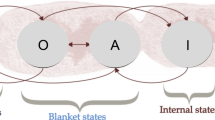Abstract.
An overview of mechanistic and functional accounts of stimulus generalisation is given. Mechanistic accounts rely on the process of spreading activation across units representing stimuli. Different models implement the spread in different ways, ranging from diffusion to connectionist networks. A functional account proposed by Shepard analyses the probabilistic structure of the world for invariants. A universal law based on one such invariant claims that under a suitable scaling of the stimulus dimension, generalisation gradients should be approximately exponential in shape. Data from both vertebrates and invertebrates so far uphold Shepard's law. Some data on spatial generalisation in honeybees are presented to illustrate how Shepard's law can be used to determine the metric for combining discrepancies in different stimulus dimensions. The phenomenon of peak shift is discussed. Comments on mechanistic and functional approaches to generalisation are given.
Similar content being viewed by others
Author information
Authors and Affiliations
Additional information
Accepted after revision: 10 September 2001
Electronic Publication
Rights and permissions
About this article
Cite this article
Cheng, K. Generalisation: mechanistic and functional explanations. Anim.Cogn. 5, 33–40 (2002). https://doi.org/10.1007/s10071-001-0122-7
Received:
Published:
Issue Date:
DOI: https://doi.org/10.1007/s10071-001-0122-7




